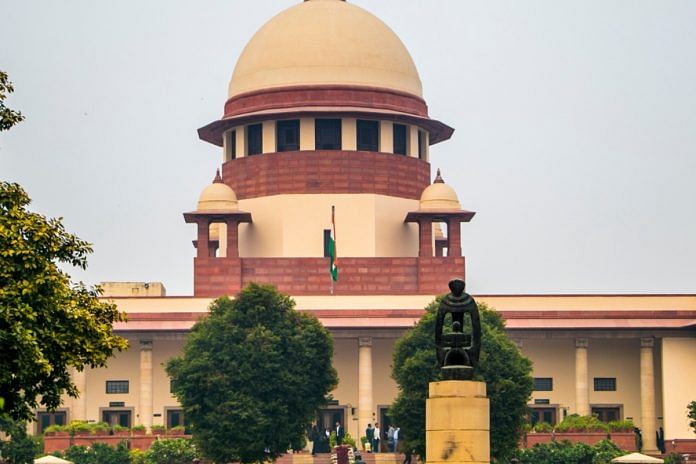New Delhi: Twenty eight years after the murder of six members from a Pune family and their domestic help, the Supreme Court has ordered the immediate release of a death row convict after he was found to be a juvenile at the time of the crime.
The convict was arrested from his village in Rajasthan eight days after the murder of seven people, including two children and a pregnant woman, in a robbery attempt at their residence.
“He (convict) shall be set free forthwith from the correctional home in which he remains imprisoned, as he has suffered imprisonment for more than 28 years, having regard to the provisions of Section 18 of the 2015 Act,” a bench of justices K.M. Joseph, Aniruddha Bose and Hrishikesh Roy said Monday.
A trial court in Pune had handed the death sentence to him and two other accused in February 1998, while his conviction and sentence were upheld by the high court the next year. In 2000, the convict moved the Supreme Court which turned down his appeal against the conviction and sentence.
While he had not raised the claim of juvenility during the trial, Narayan Chetanram Chaudhary in 2018 filed an application in the top court under Section 9 (2) of the Juvenile Justice (Care and Protection of Children) Act.
The abovementioned clause says that the court is legally bound to order an inquiry to determine the age of an accused who claims juvenility.
Subsequently,the top court referred the matter to the Principal District and Sessions Judge, Pune to decide the juvenility of the man. In a report, the juvenility claim was sustained by the inquiring judge in 2019.
The convict had pleaded that his actual name is Niranaram and that he was a juvenile at the time of the crime. He also requested release from custody on the ground of having served more than the maximum punishment permissible under the Act.
His co-convict Raju had turned approver and was pardoned during trial of the case.
Later, Chaudhary and the third convict, Jeetendra Nainsingh Gehlot, had filed mercy petitions to the President after which Gehlot’s death sentence was commuted to life imprisonment in 2016. Chaudhary, on the other hand, withdrew his mercy petition and filed a review petition in the top court in 2000 but it was dismissed.
Some human rights activists and a lawyer again wrote to the President in 2006 on behalf of Chaudhary, claiming that he was 13-year-old at the time of offence to request cancellation of his death penalty on the ground that he was a juvenile at the time of the offence.
In 2013, the convict also filed a writ petition under Article 32 of the Constitution, representing himself as ‘Narayan@Niranaram’ and seeking quashing of the order of punishment on the ground of him being a juvenile. The Supreme Court, however, dismissed the writ petition.
In the latest instance, the SC did not take this dismissal as res judicata (case already been decided) saying that Article 32 is discretionary in nature and that the dismissal order of the writ was not supported by reason.
Also Read: How a 15-yr-old spent 5 yrs on death row for rape-murder before being released by Supreme Court
Declaring juvenile & discrepancy in name
To declare the man as a juvenile at the time of offence, the apex court referred to several documents such as birth certificate and transfer certificate issued by his school in Rajasthan.
The SC noted that his claim of juvenility was primarily based on a ‘certificate’ of date of birth issued by the Headmaster of Rajakiya Adarsh Uccha Madhyamik Vidyalaya, Jalabsar, Sri Dungargarh (now in Bikaner district) on 30 January 2019, in the name of ‘Niranaram’.
In the certificate, it was recorded that Niranaram was born on 1 February 1982. According to a ‘transfer certificate’ issued on 15 August 2001, it showed that he had joined the school in Class I on 1 April 1986 and left 15 May 1989 as Class III passout.
These certificates, the Supreme Court said, show that the convict’s age on the time of offence would have been 12 years and 6 months.
It also noted that people in Rajasthan may be accustomed to pronouncing ‘Niranaram’ easily, but those in Maharashtra, especially from Pune, may find it difficult to pronounce which is why ‘Niranaram’ might have been pronounced as ‘Narayan’ in Pune.
The apex court also said that the state did not produce any material to show that there was any other Niranaram.
Accepting the inquiry report that Niranaram has to be said to be another name of ‘Narayan’, the top court said that while the man has to establish his case, it should also be appreciated that a death row convict in prison for over 28 years would be under severe limitations in retracing his school records and other forms of age proof
(Edited by Tony Rai)
Also Read: Woman showed ‘no sign of trauma, shock,’ high court gives bail to former Punjab MLA in rape case



